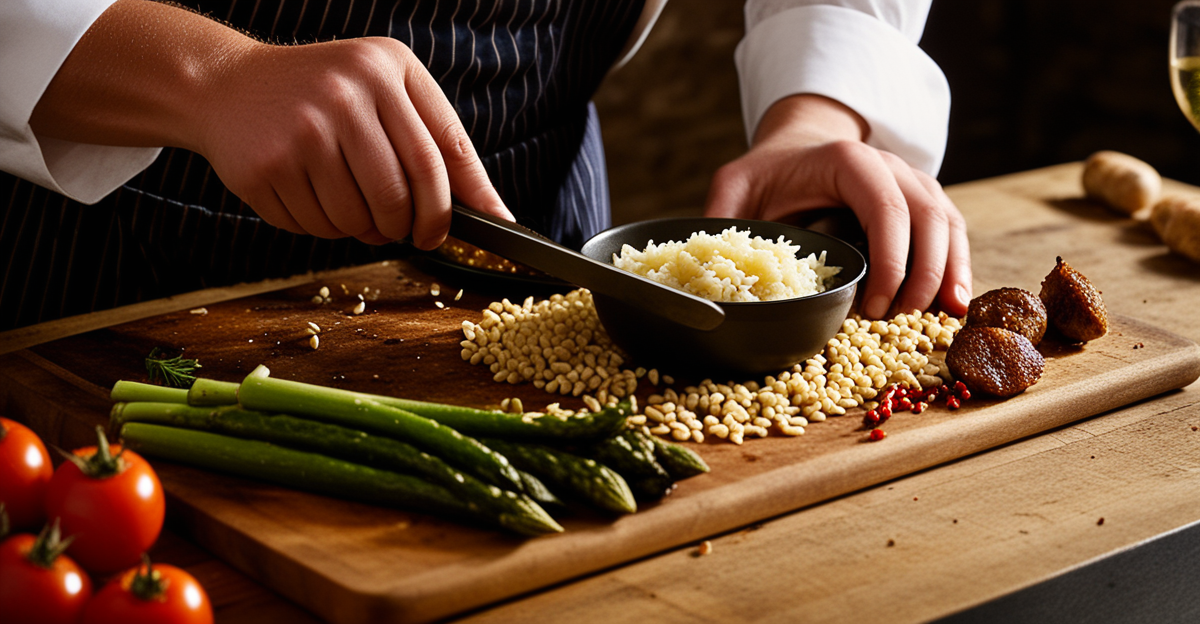Overview of Traditional British Cooking Techniques
British cuisine has a rich tapestry woven from traditional cooking methods that reflect its cultural and historical context. Foundational techniques like roasting, boiling, baking, and stewing emerged from practical needs tied to local ingredients and available tools. For instance, roasting was central due to the abundant livestock and communal family meals, while boiling and simmering suited the use of root vegetables and tougher meats.
The historical backdrop — including agricultural practices and social structures — shaped how these methods developed. British culinary history shows a consistent reliance on slow cooking and resourcefulness, often optimizing less tender cuts of meat through stewing and braising. These techniques emphasized tenderness and flavour, ensuring sustenance was both satisfying and efficient.
In parallel : What Are the Secrets Behind Traditional UK Ingredients?
Despite technological advances, these traditional methods remain vital in iconic dishes like the Sunday roast and Lancashire hotpot. They embody the culinary heritage and continue to influence modern British cooking, preserving a connection to the past while adapting to contemporary tastes. Understanding these methods provides practical insight into why British food culture thrives on hearty, well-prepared meals grounded in tradition.
Overview of Traditional British Cooking Techniques
British cuisine is deeply rooted in traditional cooking methods that have been shaped by centuries of history. These techniques, such as roasting, boiling, and baking, formed the backbone of everyday meals as well as festive feasts. Historically, British culinary history reflects the influences of geography, climate, and social structures, which dictated the resources available and the preferred cooking styles.
This might interest you : How do you make a homemade sticky toffee pudding?
For example, roasting over an open flame was not just practical but a communal event, central to the iconic Sunday roast. Boiling and simmering were common due to the availability of hearty root vegetables and tougher meat cuts, which required slow cooking for tenderness and flavour. Baking, often carried out in communal ovens, allowed for both savory pies and sweet puddings to flourish in British kitchens.
Despite technological advances, many of these traditional cooking methods continue to define the character of British dishes today. Their enduring relevance is evident in how classic recipes still rely on time-tested techniques, preserving the distinct flavours and textures celebrated in British culinary history. Understanding these foundational methods provides insight into the persistent charm and authenticity of British cuisine.
Roasting in British Cuisine
Roasting has long been a defining element of British cuisine, deeply embedded in its culinary fabric. Traditionally, roasting involved cooking meat over an open fire or in a large hearth, a method well-suited to the abundance of livestock in the British countryside. The Sunday roast, featuring cuts of beef, lamb, or poultry, remains an iconic dish that directly reflects these roots.
Classic British roast dinners include accompaniments like roasted potatoes, Yorkshire pudding, and seasonal vegetables, all cooked together to enhance flavours harmoniously. Roasting’s appeal lies in its ability to create a crisp exterior while maintaining succulent, tender meat inside—a balance celebrated in British homes for generations.
Modern ovens have evolved roasting from an outdoor or hearth-based activity into a precise kitchen art, with controlled heat settings improving consistency. Despite technological advances, the fundamental principles of roasting have stayed intact, ensuring that this traditional cooking method continues to be central in British food culture.
Whether preparing a beef joint or a whole chicken, roasting showcases the best of British culinary history by blending practicality with rich, comforting flavours, making it a proudly preserved and practised cooking tradition.
Roasting in British Cuisine
Roasting has long been a defining traditional cooking method within British cuisine. Its roots trace back to communal fires where whole animals were hung and cooked over open flames, creating a social event centered around the meal. Roasting became a hallmark due to the plentiful availability of meats such as beef, lamb, and poultry, which benefit from dry heat to develop rich flavours and tender textures.
The iconic Sunday roast exemplifies roasting’s enduring significance—it typically features a roasted joint of meat served with roasted potatoes and seasonal vegetables. This dish has remained central to British culinary history, symbolizing both family tradition and celebration.
Comparing traditional roasting with modern oven techniques reveals continuity and innovation. While earlier methods relied on unpredictable open flames, contemporary ovens offer precise temperature control, ensuring consistent results without sacrificing the deep flavours roasting provides. This balance preserves the authenticity of British roast dinners while accommodating today’s culinary standards.
Roasting’s appeal lies in its simplicity and ability to transform hearty ingredients into memorable meals. It remains integral in British kitchens, a living link between past and present culinary practices.
Boiling and Simmering Techniques
Boiling and simmering have been fundamental traditional cooking methods in British cuisine, especially suited to the preparation of hearty dishes like English stews, broths, and puddings. Boiling involves cooking food in rapidly bubbling water or stock, whereas simmering uses gentler heat just below boiling, ideal for extracting rich flavours without toughening meats.
Typical dishes such as Lancashire hotpot or beef and vegetable stews rely on these techniques to tenderise tougher cuts of meat and meld flavours over time. Simmering, in particular, allows for prolonged cooking, which develops depth and character in these traditional soups and slow-cooked meals.
Historically, boiling and simmering were practical, as they required only a simple hearth and durable pots. These methods were well-suited to British ingredients like root vegetables and game, which often needed softening to be palatable.
The distinction between boiling and simmering mattered greatly in British culinary history—boiling was faster but risked overcooking, while simmering preserved texture and enhanced taste. This balance remains crucial today, with many classic recipes emphasizing simmering to maintain authenticity in flavour and tenderness.
Ultimately, boiling and simmering continue to be essential in crafting comforting British dishes, showcasing the enduring value of these practical, flavour-focused techniques.
Boiling and Simmering Techniques
Boiling and simmering hold a significant place in British cuisine, especially within the context of traditional cooking methods. These wet-heat techniques were essential for transforming tougher cuts of meat and hardy vegetables into tender, flavorful meals. Unlike boiling, which involves cooking food at a vigorous bubble-and-agitate stage, simmering is gentler—maintaining a lower temperature just below boiling to preserve texture and enhance flavour.
In British culinary history, boiling and simmering were commonly used for dishes like English stews, broths, and puddings. Stews such as the classic Lancashire hotpot rely on simmering to gently meld ingredients over a long period, yielding a rich, cohesive dish. Simmering also plays a crucial role in making traditional soups, where slow cooking extracts maximum flavour without breaking down the components too harshly.
The distinction between boiling, simmering, and poaching is important. Boiling is suitable for quick cooking but can cause tough meats to seize or vegetables to disintegrate. Simmering allows gradual heat penetration, ideal for tenderising. Poaching, milder than simmering, often applies to delicate items. Understanding these subtleties elucidates the practicality and endurance of boiling and simmering in British culinary history and their continued relevance in hearty, satisfying dishes.
Overview of Traditional British Cooking Techniques
British cuisine is rooted in traditional cooking methods that emerged from practical needs shaped by geography, climate, and historical social structures. Roasting, boiling, baking, stewing, and simmering have been foundational to British kitchens for centuries. These techniques made the most of local ingredients, such as tougher cuts of meat and hardy root vegetables, ensuring food was both nourishing and flavorful.
Historically, the availability of resources and communal dining shaped these methods. For example, roasting over open fires suited abundant livestock, while boiling and simmering enabled slow tenderization. Baking, often performed in communal ovens, fostered the development of savory pies and sweet puddings, reflecting both utility and culinary creativity.
The historical backdrop of British culinary history shows a focus on resourcefulness and techniques that transform simple ingredients into hearty meals, especially during times when food had to stretch to feed families. Such traditions continue to influence iconic dishes today, including the Sunday roast and Lancashire hotpot, maintaining a tangible connection between the past and present.
In essence, these traditional cooking methods remain vital in British cuisine, prized for their practicality and the depth of flavor they produce, underscoring their enduring role in Britain’s culinary heritage.





